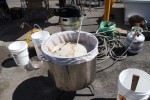 Recipe: check. Ingredients: check. Friends: check. Pint: check. This is no ordinary day. This is a brew day.
Recipe: check. Ingredients: check. Friends: check. Pint: check. This is no ordinary day. This is a brew day.
Whether you’ve brewed a thousand times or if your homebrewing cherry is about to succumb to the wrath of beer, every homebrewer knows that a brew day is not just another day. Some people abide by a strict regimen of brew day tradition with little deviation, while others have little preparation and let the proverbial pieces fall as they will throughout the day. Even the most experienced homebrewer will have brew day hiccups that require quick thinking. If you don’t, then maybe you should consider brewing professionally, or at least show me how you do it. Half the fun of brewing at home is learning from your mistakes, and improving as you soak up experience.
First things first: pour yourself a pint. If this is your first time, this step is of utmost importance since it will help settle that unsure brain of yours. In the words of the homebrewing legend Charlie Papazian, “Relax. Don’t worry. Have a homebrew.” If this is your hundredth brew, then you shouldn’t have to be reminded. I don’t buy into all that New Age-y stuff, but I don’t think it hurts to become one with the beer, and what better way to do that than to consume it. So drink up, it’s for the greater good.
After your glass is full, it’s time to brew. Though sanitization is not an extreme priority before the boil, I still like to play it safe and give everything a good rinse with Star San since I’m not really sure what crawls around on my equipment in my basement. While I am cleaning and setting up, I like to heat a few gallons of water up to around my mash temperature and dump it into my mash tun to get it preheated to avoid drastic temperature drops throughout the mash. Once everything is set up and my strike water is on target, I begin mixing the grain and water into my mash tun. Getting the mash temperature right where you want it may be one of the trickiest aspects of the day, but once that thermometer is right on the money, you’re cookin’ (literally). Depending on how productive I feel, the 60 minute mash is either a time to start bottling or racking a previous batch, or a time to pour another pint and review my mental checklist.
After the mash, and all of the necessary starches have converted to fermentable sugars, it’s time to sparge, or the process of rinsing off the sugars from the grain. I have a bazooka screen as my false bottom, so batch sparging is the best method for me. After running off all of the liquid in the tun, I add more water until I have my targeted pre-boil volume and gravity. Once you have your wort (sugar water/unfermented beer), it’s time for the boil, which, again, is another time for multi-tasking or a time of elixir-sipping and shootin’ the breeze with your brewing companions.
The boil is typically an hour, and it is most necessary for the isomerization of the alpha acids in the hops. It is also necessary for evaporating off some of the liquid and unwanted toxins, as well as for bringing up the gravity points of the final product. The hops are added at different times throughout the boil for bittering and aromatics. Towards the end of the boil, Irish moss is added to help in the coagulation of the unwanted proteins, which form the trub. Once the 60-minute boil is complete, it is necessary to cool the wort as fast as possible. My personal set up uses a copper immersion chiller, which works like a charm, especially in cooler weather. Not only do you need to get your wort to a pitchable temperature for your eager yeast, but you also need to cool it down as fast as you can because it considerably slows down the production of dimethyl sulfide (DMS), an unwanted substance that produces a vegetal off-flavor.
Once the wort is chilled to appropriate pitching temperatures, usually between 68 and 75 degrees, it is time to pitch the yeast. Everyone has their brew day traditions, and mine involves gathering everyone who helped during the day around the primary fermenter and making everyone put their hand on the flask to help pitch the yeast. Your traditions may be something similar or something more meaningful, but whatever they are, it’s all part of the process. Traditions not only make brew days more significant, they also make you feel more connected with your beer (New Age? More like Brew Age).
Now you see why a brew day is not a typical day. It is a day when most everything else is set aside and people partake in the creation of something wonderful. Whether your brew day reaches ritualistic cult status that may or may not involve sacrifices to the beer gods (just make sure you’re drinking beer and not kool-aid), or whether it is just a relaxing time to hang out and brew with friends, it is certainly a day like no other. Move over chores. Move over homework. Move over wife (is it too late to take that one back?). It’s time to brew.





